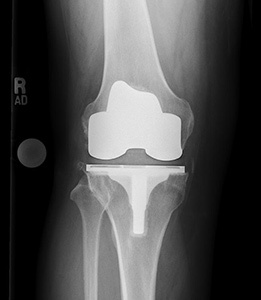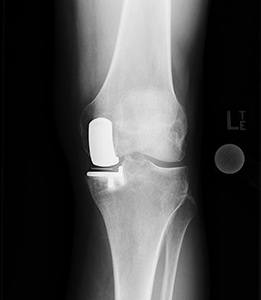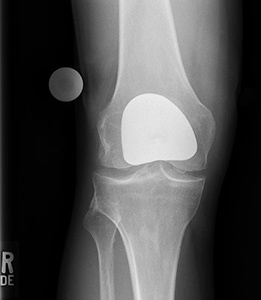Total knee replacement
Total knee replacement (TKR) was developed at Hospital for Special Surgery in the 1970′s as a way to treat end-stage arthritis of the knee. Since that time, the techniques, surgical instruments, and implants have been refined to ensure that TKR is one of the most successful, reproducible, and quality-of-life enhancing operations. TKR can relieve patients of the daily pain and stiffness of an arthritic knee, allowing patients to return to an active lifestyle without limitations.
The implant for a total knee replacement is composed of 4 parts: the tibial and femoral components, a plastic insert, and the patella. The tibial and femoral components are made out of metal, usually cobalt-chrome, and are used to cap the ends of the femur and tibia after the arthritic bone is removed. The plastic insert is made out of ultra high molecular weight polyethylene (UHMWPE) and fits into the tibial component, such that the highly polished surface of the femur glides against the plastic. The patella component is also made of UHMWPE, and glides against the front of the femoral component. All together, the components weigh about 1 to 2 lbs. They are generally fixed to the bone with cement.
Unicompartmental knee replacement
A unicompartmental knee replacement (UKR), or partial knee replacement, is an artificial knee that only replaces one of three compartments of the knee. This operation is best suited to patients who have arthritis limited to this one area. The benefits of a UKR are a less-invasive surgery, quicker recovery, greater range of motion, and more natural feeling knee. Therefore, it is well-suited to many younger, active patients who have arthritis limited to one area of the knee.
Most unicompartmental knee replacements are performed on the medial (inner) aspect of the knee, as this is the first area that the cartilage usually wears out. Typically, patients will feel pain only on the inner side of their knee when they weight-bear (stand or walk) for a period of time. Less commonly, the patello-femoral (kneecap joint) is worn out in isolation. Patients with patellofemoral arthritis usually have anterior (frontal) knee pain with stairclimbing and rising from a seated position. Isolated patellofemoral arthritis can also be replaced with a partial knee replacement.
Because there are 2 remaining compartments of the knee that are retained after a partial knee replacement, arthritis may develop in these native compartments in the future. Therefore, progression of arthritis in the other areas of the knee is the greatest cause of revision of UKR.

X-ray of
total knee replacement

X-ray of
Unicompartmental knee
replacement

X-ray of
patellofemoral replacement


